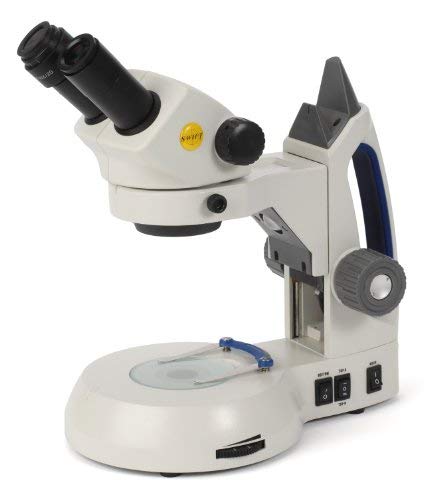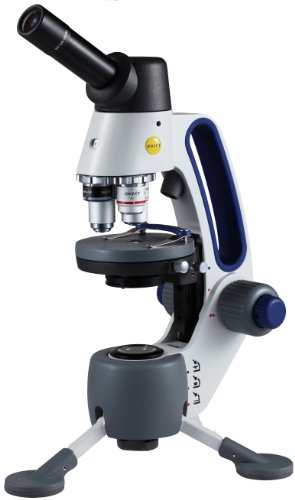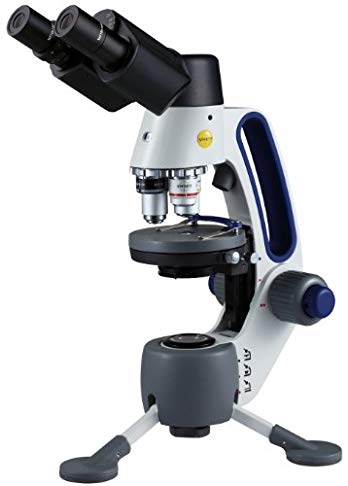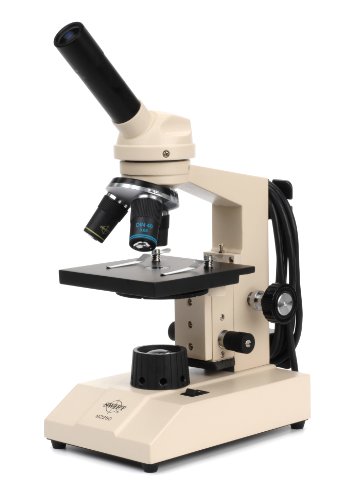The Swift Optical SM105 binocular stereo zoom microscope has 10x widefield eyepieces, a fixed 45-degree angle viewing inclination, 55 to 75mm inter-pupillary adjustment, 360-degree rotation, 1x to 3x zoom objective for 10x to 30x total optical magnification, upper/turret/lower LED lighting, a fixed stage with dual focusing knobs, a frosted 80mm glass plate with clips, and a reversible (black/white) 80mm stage plate. The binocular viewing head has eyepieces with inter-pupillary adjustment, rubber eyepiece shields to block ambient light, fixed inclination to reduce eye and neck strain, dioptric adjustment in the right eyepiece to accommodate individual eye strength differences, and 360-degree rotation capability to provide a more comprehensive view and enable sharing. Parcentered and parfocal objectives ensure that the image stays centered and focused when the magnification is changed. Achromatic objectives provide color correction of magnified images. The objectives provide low magnification and a longer focal length for inspecting large-scale specimens, or specimens that require hands-on manipulation or repair, including rocks, minerals, watches, or circuit boards. The microscope has variable upper (episcopic) illumination that reflects light off the specimen for enhanced visibility of opaque specimens, six-bulb variable turret, and lower (diascopic) illumination that transmits light up through the specimen for enhanced visibility of translucent and transparent objects. The LED light source provides bright, cool light for working with temperature-sensitive or live specimens. The lights are controlled by two switches that offer five different configurations (turret, upper, lower, simultaneous turret and lower, or simultaneous upper and lower) and the intensity of the upper and turret lights is controlled by a rheostat. The frosted glass stage plate allows light to pass through from below and has a blue filter for increased resolution. The reversible black and white stage plate is used with top-mounted (episcopic) lighting to provide contrast with light- and dark-colored specimens. The fixed stage has stage clips to secure the slide or specimen in place while viewing. Dual knobs on a rack-and-pinion mount with a slip clutch and tension control provide precise focus. A stereo zoom microscope is used for inspection and dissection specimens when three-dimensional images are desired, and provides zoom, sometimes called pancratic, magnification that allows the user to zoom in on the specimen within a continuous magnification range.
The microscope frame is constructed of cast metal and has a gray enamel finish for durability. It comes with a power cord and has a cord holder for storage. The microscope is 12-1/2 x 7-1/2 inches (H x W, where H is height, the vertical distance from the lowest to highest point; and W is width, the horizontal distance from left to right). A USB port can be used to add-on accessories such as USB lighting. It comes with a vinyl dust cover and molded polystyrene foam container.
| Microscope Head and Optics Specifications | |
|---|---|
| Head | Binocular |
| Magnification | 10x to 30x (field of view: 10x/20mm, 20x/10mm, and 30x/6.5mm) |
| Head inclination | 45 degrees |
| Head rotation | 360 degrees |
| Interpupillary adjustment | 55 to 75mm |
| Eyepieces | Widefield 10x |
| Objective | 1x to 3x zoom, parfocal, parcentered, achromatic objectives |
| Microscope Illumination and Stage Specifications | |
|---|---|
| Focus type | Dual knobs, mounted on rack-and-pinion mechanism with slip clutch and tension adjustment |
| Working distance | 77mm |
| Maximum specimen height | 36mm |
| Light source | LED |
| Illumination type | Variable turret with six 0.06W LEDs, variable upper with 0.5W LED, and lower with 0.5W LED |
| Stage type | Fixed, 80mm frosted glass stage plate, 80mm reversible (black/white) plastic stage plate, two stage clips |
| Microscope dimensions | 12-1/2 x 7-1/2 inches (H x W) |
| Weight | 10lb. |
Microscopes are instruments used to enhance the resolution of an object or image. Types include compound, stereo, or digital. Compound microscopes use a compound optical system with an objective lens and an eyepiece. Stereo microscopes show object depth in a three-dimensional image. Digital microscopes are used to display an image on a monitor, rather than looking through a lens. Microscopes can have monocular (one), binocular (two), or trinocular (three) eyepieces, with varying magnification abilities. Magnification ability refers to the size of an image. Resolution, also known as resolvant power, refers to the clarity of the image. The interaction between field of view (FOV), numerical aperture (NA), and working distance (WD) determines resolution. Microscopes can control magnification through a fixed focus, or through a range of adjustments. They can also utilize LED, fluorescent, and mirror light sources to help control viewing capabilities. Microscopes are widely used in education, lab research, biology, metallurgy, engineering, chemistry, manufacturing, and in the medical, forensic science, and veterinary industries.
Swift Optical Instruments manufactures microscopes and weather instruments. The company, founded in 1959, is headquartered in Schertz, TX.
What’s in the Box?
- Swift Optical SM105 microscope
- (2) 10x widefield eyepiece
- 1x-3x achromatic zoom objective
- (2) eye shields, rubber
- Stage plate, frosted glass
- Stage plate, reversible black/white
- Blue filter
- Dust cover, vinyl
- Container, polystyrene foam
- Instructions




